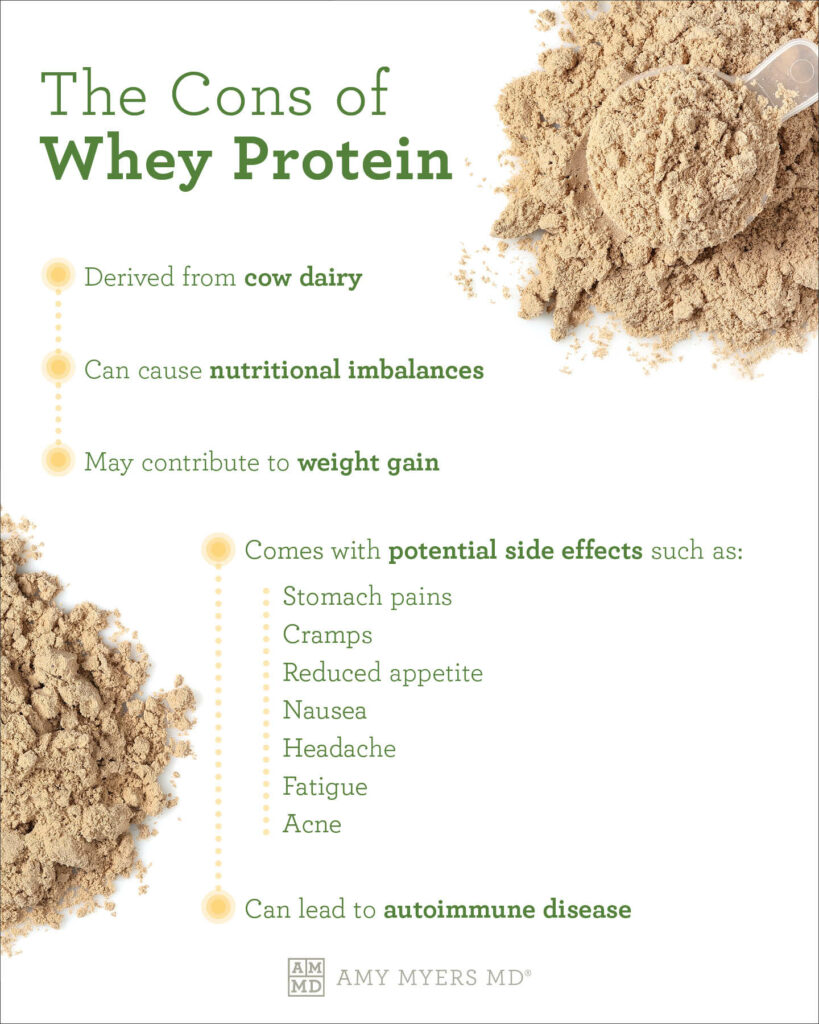Whey protein is a popular supplement for those trying to build muscle mass, lose weight, or just to add more protein to their diet. It is the gold standard in the fitness industry, however there are several cons of whey protein that outweigh the benefits.
Whey is one of the two proteins found in cow’s dairy. I’ll discuss why you should remove dairy products, including whey protein supplements, from your diet later in this article. The good news is there are great alternatives to whey protein that provide the same benefits.
Protein is an essential macronutrient. Your body needs it for cell rebuilding, supporting bone health, and metabolic processes during digestion. However, not all sources of protein are created equal. In fact, the whey protein you are taking may negatively affect your health instead of helping it. So, what exactly is whey protein?
What is Whey Protein?
Cow’s milk has two proteins – casein and whey. Whey protein is often separated from casein in milk. It can also be created as a byproduct of cheese making. It accounts for 20% of milk’s protein.1 Casein makes up the other 80% of the protein in milk.
Protein molecules consist of hundreds or thousands of amino acids that are linked together. There are 20 different types of amino acids and the sequence of these amino acids determines the specific three-dimensional structure and subsequent function of each protein. These molecules are the workhorses of your body.
Whey protein is a complete protein because it contains the 9 essential amino acids – histidine, isoleucine, leucine, lysine, methionine, phenylalanine, threonine, tryptophan, and valine. Your body cannot make essential amino acids, so the only way to get them is through food such as meat, eggs, and poultry.
One of the biggest cons of whey protein is that it does harbor lactose, a sugar found in milk that many people have trouble digesting. I’ll talk more about that in just a minute and why I believe everyone should remove dairy from their diet. While whey protein does contain lactose, the isolate version found in some whey protein supplements contains very little. Yet, even the smallest amount of lactose can cause digestive problems. Let’s discuss the differences between whey protein concentrate and whey protein isolate.
Whey Protein Concentrate vs. Isolate
If you’re browsing the hundreds of whey protein bars, shakes, and powders available, you’ll notice some labeled “whey protein concentrate” and some are labeled “whey protein isolate.” The main difference is the amount of lactose and casein protein included in each product.2 While some people are sensitive to both casein and whey, casein protein is much more difficult to digest than whey for a lot of people. I’ll talk more about that in just a minute.
As I mentioned, whey is a byproduct of the cheese making process. Makers use enzymes to curdle the milk. The leftover liquid is whey protein. This liquid is pasteurized to make three types of whey protein: concentrate, isolate, and hydrolysate. Here’s what each of the terms mean:
- Concentrate: Whey protein concentrate is what is found in many protein shakes and bars. It has higher amounts of casein and lactose, however, the amounts vary between products. If you have a dairy sensitivity, this can cause symptoms such as bloating, diarrhea, gas, stomach pain, seasonal allergies, fatigue, and headaches.
- Isolate: Whey protein isolate is a process where producers isolate the way protein from casein, and reduce the fat and lactose content. While this form of whey protein seems better, it’s important to remember that whey and casein are not eliminated. It can still cause digestion issues in people with lactose intolerance.
- Hydrolysate: When the whey protein chains are hydrolyzed, their protein chains are broken down, which makes them easier to digest. Just as they are in collagen protein powders. This is the type of whey used in infant formulas. However, even hydrolyzed whey protein contains some casein and lactose.
I don’t recommend anyone use whey protein because, no matter how hard manufacturers try, there is no guarantee that the protein powder is free of lactose and casein. Let’s go further in detail about the cons of whey protein.
The Cons of Whey Protein and Casein
You can probably tell there’s a common theme in regards to whey protein. Lactose intolerance is very common in adults, affecting more than 30 million people. Casein intolerance is less common, yet the symptoms can be more severe. Lactose and casein are the two biggest cons of whey protein, which is why I recommend everyone avoid whey protein powders. Let’s talk more about the cons of whey protein.

It Contains Dairy
Dairy causes inflammation in a large percentage of the population, either due to lactose intolerance or casein sensitivities.
Lactose intolerance occurs in people whose body stops producing the lactase enzyme that aids in the digestion of lactose, a sugar found in cow’s milk. It is estimated that about 70% of the world’s population stops producing lactase once they have finished breastfeeding.3
Because of casein, people who produce the lactase enzyme can still experience dairy sensitivity. Remember, casein has a similar molecular structure as gluten. If you have a dairy sensitivity, you likely also have a sensitivity to gluten.
You may not realize it’s dairy causing your bloating, gas, headaches, fatigue, eczema, or other symptoms. As a result, your system can become chronically inflamed as you continue to snack on cheese, add milk to your coffee, and slather butter on vegetables, damaging your gut lining with each exposure. This can put you further along the Autoimmune Spectrum®, and eventually a full-blown autoimmune disease.
Dairy is often full of hormones and antibiotics.
When you consume a whey protein product—or any form of dairy product it likely isn’t from organic sources, which means it’s full of GMOs, hormones, or antibiotics.
To increase milk production, American dairy farmers inject their cows with the genetically engineered bovine growth hormone rBGH. The increased milk production puts a strain on the cows’ udders. This often leads to an infection known as mastitis, which is then treated with antibiotics.
All of those added hormones and antibiotics make their way into the dairy products you eat, including whey protein powders. The additives contribute to acne, mood swings, and antibiotic resistance. In turn, it could lead to serious illness caused by antibiotic-resistant infections.4
Casein and Molecular Mimicry
While some people are sensitive to both casein and whey, casein protein is much more difficult to digest than whey. The real issue with casein comes from the molecular mimicry of gluten. Nearly 30% of the population has gluten sensitivity, however, an estimated 99% of those people with gluten sensitivity are undiagnosed.
When your immune system is continuously creating inflammation in response to the gluten you’re eating, it causes a leaky gut, which then allows microbes and toxins to flood your bloodstream, and eventually leads to chronic inflammation. When this happens, your immune system begins indiscriminately sending wave after wave of attacks in a desperate attempt to fight off the invaders. Eventually, your body’s own tissues end up on the receiving end of the attack, and you end up with an autoimmune disease.
The only way to give your immune system the break it needs to regain its precision so that it can stop mistakenly attacking you, is to remove gluten entirely. And since casein mimics gluten, you also need to remove dairy completely.
Whey Protein Alternatives
There are many benefits to protein, which I am about to tell you about. However, a lot of so-called fitness industry experts will tell you that you can only get protein from your diet and whey protein. They are only partially correct.
Animal protein is the best source of protein. I always recommend that you buy organic meats, fruits and vegetables. However, I understand that can be expensive, so at the very least, your meat should come from organic sources such as grass-fed beef, free-range chicken and poultry, and wild-caught seafood to ensure you’re getting the best protein possible from your foods.
While plant protein may seem like a good whey protein alternative, it’s not a complete protein. I was a vegetarian for over 20 years and I ultimately discovered that this played a big role in why I developed an autoimmune condition. In the years since I was diagnosed with Grave’s disease, I have done extensive research and made a big shift in my own diet. Now I recommend that anyone dealing with autoimmunity add animal protein into your diet. When it comes to plant protein vs. animal protein, animal protein is the clear winner!
The Benefits of Animal Protein
Protein molecules are the frontline workers for your body. Protein is critical to sustaining human life. Your body is constantly breaking down and rebuilding all manner of structures and systems. You need the amino acids in complete proteins to help build and repair every single structure in your body. This requires a great amount of dietary protein every day to be done correctly and efficiently. The USDA guideline is that adults should get 10 to 35% of their total calories from protein.5
Here is how protein benefits your body:
- Reduces appetite and hunger levels: Studies show that protein reduces the hunger hormone ghrelin and boosts levels of peptide YY, a hormone that makes you feel full.
- Increases muscle mass and strength: Protein is a building block of your muscles. It is essential to increase lean muscle mass.
- It’s good for bone health: Research indicates that protein, especially animal protein, helps support bone mass as you age.
- Reduces sugar cravings: Increasing your protein intake curbs sugar cravings.
- Boosts metabolism and increases fat burning: Protein can help you boost your fat metabolism by making you burn more calories during the day.
- Supports weight loss: Because protein boosts metabolism and suppresses your appetite, it naturally supports healthy weight loss.
- Helps your body recover after injury: Remember, protein is the building blocks of your cells. Getting high protein amounts can help you recover faster after an injury.
If you’re wondering how to get optimal amounts of protein without using whey protein, I’ve got great news for you!
The Best Whey Protein Alternative
One-third of adults over age 50 fail to meet their daily recommended allowance for protein intake!6 That’s frustrating because it’s so easy to ensure you are getting high protein amounts. One convenient way to get more protein in your diet is by replacing a meal or snack with a smoothie containing a high-quality protein powder.
Unfortunately, it can be hard to find dairy-free, animal protein. The cons of whey protein greatly outweigh the benefits due to the lactose and casein content. Plant protein, while a dairy-free source, does not provide you with the essential amino acids only found in animal protein. It can be frustrating it can be trying to find a protein powder.
I went five years without using a protein powder because I couldn’t find one that met my dietary needs. Finally, I decided enough was enough and formulated The Myers Way® Paleo Protein powders!
The Myers Way® Paleo Protein powders are made with the purest ingredients sourced from non-GMO, hormone- and antibiotic-free, grass-fed bovine collagen, and are richer, creamier, healthier, and more delicious than any other protein on the market. The best part is that it does not contain whey and casein proteins. So you’re getting all the benefits of a protein supplement without the dangers of dairy! I personally enjoy a scoop in my morning smoothie or as part of a delicious high-protein dessert or snack, depending on which flavor I am craving.
Whey protein is sold in the fitness industry as a miracle protein to build muscle mass and support weight loss. I’m here to tell you that’s not the case. You can get all the benefits in a Paleo protein powder without the cons of whey protein.










Leave a Comment